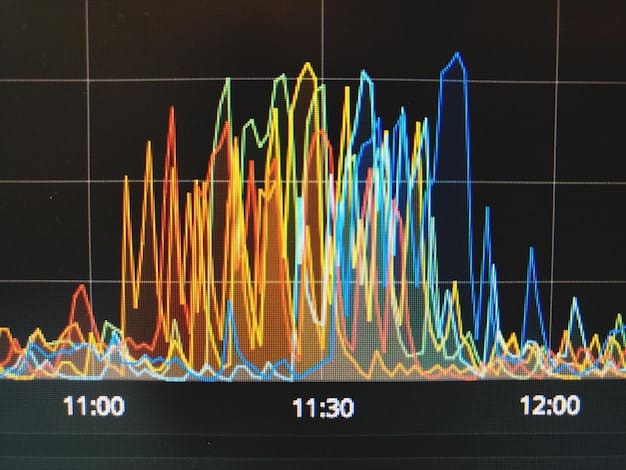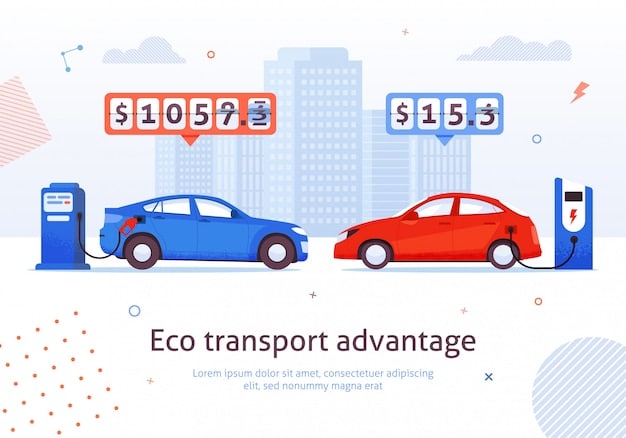Rising Battery Costs: Impact on Electric Vehicle Affordability in the US

Analyzing the Impact of Rising Battery Costs on the Affordability of Electric Vehicles in the US Market reveals a complex interplay, where advancements in battery technology and increased production are counteracted by raw material price volatility and geopolitical factors, potentially slowing down the mass adoption of EVs in the United States.
The dream of affordable electric vehicles (EVs) for every American is facing a significant hurdle: the rising cost of batteries. This article provides an in-depth analyzing the impact of rising battery costs on the affordability of electric vehicles in the US market, exploring the factors driving these costs and what it means for the future of EV adoption.
Understanding the Landscape of EV Battery Costs
The cost of batteries is a crucial factor in determining the overall price of electric vehicles. As battery technology advances, the expectation is that prices should decrease, making EVs more accessible to a broader consumer base. However, recent trends suggest a more complex picture, with various elements influencing the final cost.
Key Components of Battery Costs
Several components contribute significantly to the overall cost of an EV battery. Understanding these components is essential to grasping the dynamics of battery pricing and its impact on EV affordability.
- Raw Materials: Lithium, nickel, cobalt, and manganese are crucial raw materials. Their prices fluctuate significantly due to supply and demand dynamics, geopolitical factors, and mining challenges.
- Manufacturing Processes: The sophistication and efficiency of battery manufacturing processes play a vital role. Advanced manufacturing techniques can reduce production costs and improve battery performance.
- Research and Development: Ongoing investment in R&D is essential for developing more efficient, longer-lasting, and cheaper batteries. Innovations in battery chemistry and design can lead to significant cost reductions.
- Economies of Scale: As EV production increases, economies of scale can drive down battery costs. Mass production allows manufacturers to spread fixed costs over a larger number of units.
The landscape of EV battery costs is multifaceted, influenced by raw material prices, manufacturing processes, R&D investments, and production scale. Each of these factors plays a critical role in determining the overall affordability of electric vehicles in the US market.
Factors Driving the Increase in Battery Prices
While technological advancements generally lead to cost reductions, several factors have been contributing to the recent increase in EV battery prices. These factors range from supply chain disruptions to increasing demand for raw materials.

Supply Chain Disruptions
Global events such as the COVID-19 pandemic and geopolitical tensions have caused significant disruptions in the supply chain for battery materials. These disruptions have led to shortages and price increases.
Rising Demand for Raw Materials
The rapid growth of the EV market has led to a surge in demand for raw materials like lithium and nickel. This increase in demand has put pressure on supply chains, leading to higher prices.
- Limited Mining Capacity: The capacity to mine and process these materials has not kept pace with demand, exacerbating the supply shortage and driving up costs.
- Geopolitical Factors: The concentration of raw material production in specific regions of the world exposes the supply chain to geopolitical risks, like trade wars or political instability.
- Environmental Concerns: Increased scrutiny of mining practices and environmental regulations also impact the supply and cost of raw materials.
The interplay of supply chain disruptions and rising raw material demand has created a challenging environment for EV battery manufacturers. Addressing these factors is crucial for stabilizing and reducing battery prices.
Impact on Electric Vehicle Affordability in the US
The rising cost of batteries directly impacts the affordability of electric vehicles in the US market. As battery prices increase, manufacturers are faced with the challenge of maintaining competitive pricing or passing the costs on to consumers.
Pricing Strategies and Consumer Impact
Manufacturers employ various pricing strategies to mitigate the impact of rising battery costs. These strategies include absorbing some of the cost increases, reducing vehicle features, or passing the costs on to consumers through higher prices.
Government Incentives and Subsidies
Government incentives and subsidies play a key role in offsetting the higher upfront costs of EVs. Tax credits, rebates, and other incentives can significantly reduce the price for consumers, making EVs more attractive.
- Federal Tax Credits: The US federal government offers tax credits for the purchase of new EVs. These credits can reduce the overall cost for consumers.
- State-Level Incentives: Many states offer additional incentives, such as rebates, tax credits, and reduced registration fees. These incentives vary by state.
- Impact on Adoption Rates: Government support helps boost EV adoption rates, encouraging more consumers to switch to electric vehicles.
Government incentives are crucial in bridging the price gap and promoting EV adoption by softening the blow of rising battery prices for consumers. The availability and extent of these incentives can significantly impact the affordability and market penetration of EVs.

Technological Advancements and Cost Reduction Strategies
Despite the challenges, ongoing technological advancements offer hope for future cost reductions in EV batteries. Innovations in battery chemistry, manufacturing processes, and recycling techniques are paving the way for more affordable EVs.
Innovations in Battery Chemistry
Research into new battery chemistries, such as solid-state batteries and lithium-sulfur batteries, holds promise for higher energy density and lower costs. These advancements could dramatically improve EV performance and affordability.
Improving Manufacturing Efficiency
Optimizing manufacturing processes and scaling up production can significantly reduce battery production costs. This includes minimizing waste, increasing automation, and improving quality control.
- Gigafactories: Large-scale battery production facilities, known as gigafactories, are crucial for achieving economies of scale and reducing manufacturing costs.
- Automation: Increased automation in battery production can reduce labor costs and improve efficiency.
- Standardization: Standardizing battery designs and components can further drive down manufacturing costs and simplify the supply chain.
By continuing to invest in R&D and scaling up efficient manufacturing processes, automakers and battery manufacturers can overcome present constraints, paving the way for more affordable and efficient batteries. Embracing innovative techniques is vital for ensuring the long-term affordability and competitiveness of EVs.
The Role of Battery Recycling
The emerging battery recycling industry plays a crucial role in mitigating the impact of rising raw material costs. Recycling end-of-life batteries can recover valuable materials and reduce the demand for newly mined resources.
Benefits of Battery Recycling
Recycling EV batteries offers several environmental and economic benefits. It reduces the need for virgin materials, decreases waste, and lowers the environmental impact of battery production.
Challenges and Opportunities
Despite the benefits, battery recycling faces technical and economic challenges. Developing efficient and cost-effective recycling processes is crucial for realizing its full potential.
- Recycling Infrastructure: Development of convenient and widespread recycling infrastructure is essential to facilitating end-of-life battery collection and processing.
- Innovative Recycling Techniques: Continuous research is needed to create more efficient and cost-effective recycling technologies.
- Regulatory Frameworks: Clear regulations and incentives are needed to encourage battery recycling and ensure proper management of battery materials.
The expansion of a robust recycling sector is vital in addressing the high raw material cost burden. By creating a circular economy for battery materials, the industry can work towards achieving more sustainable practices, while also alleviating some price pressures.
Future Outlook and Policy Implications
The future affordability of electric vehicles in the US market hinges on addressing the challenges posed by rising battery costs. Strategic policy decisions, technological advancements, and market dynamics will shape the trajectory of EV adoption.
Government and Industry Collaboration
Effective collaboration between government and industry is essential for promoting innovation, fostering sustainable supply chains, and ensuring the widespread adoption of electric vehicles.
Policy Recommendations
Policies that support raw material diversification, invest in recycling infrastructure, and promote battery R&D can help mitigate the impact of rising battery costs and accelerate the transition to electric mobility.
- Incentives for Recycling: Implement tax incentives and subsidies for recycling operations to encourage the development of recycling infrastructure.
- Invest in R&D: Fund research and development efforts to lower total cost of battery production and enhance performance through innovative, sustainable practices.
- Sustainable Mining Practices: Promote environmentally responsible mining practices.
The trajectory of electric vehicle affordability in the US depends significantly on implementing forward-thinking policy measures and ongoing cooperation between government and industry stakeholders. By addressing key impediments, the nation can advance the widespread adoption of electric vehicles and reap the economic and environmental rewards they offer.
| Key Point | Brief Description |
|---|---|
| 💰 Battery Costs | Prices are rising due to raw material demand and supply chain issues. |
| 💡 Innovation | New battery chemistries and efficient manufacturing can lower costs. |
| ♻️ Recycling | Recycling reduces raw material demand and waste, supporting affordability. |
| 政策 Government | Incentives and policies crucial for EV affordability and market penetration. |
Frequently Asked Questions
▼
EV battery costs are rising due to increased demand for raw materials like lithium, nickel, and cobalt, coupled with supply chain disruptions. Geopolitical factors and limited mining capacity also contribute to higher prices.
▼
Government incentives, such as federal tax credits and state-level rebates, can significantly reduce the upfront cost of electric vehicles, making them more accessible to a broader range of consumers.
▼
Battery recycling helps reduce the demand for newly mined raw materials, lowering the cost of producing new batteries. It also decreases waste and minimizes the environmental impact of battery production.
▼
Innovations in battery chemistry, like solid-state and lithium-sulfur batteries, along with improvements in manufacturing processes and the scaling of gigafactories, can lead to higher energy density and lower costs.
▼
Policies supporting raw material diversification, investments in battery recycling infrastructure, and funding for research and development can mitigate the impact of high battery costs and accelerate the transition to electric mobility.
Conclusion
In conclusion, the affordability of electric vehicles in the US market faces challenges due to rising battery costs, influenced by raw material prices and supply chain disruptions. Strategic efforts, including technological innovation, robust government support, and the development of sustainable battery recycling programs, are vital to mitigate these issues and make EVs accessible to a broader range of consumers. Ultimately, collaborative action between policymakers, industry stakeholders, and consumers is crucial to drive efficiency and foster widespread EV adoption.





